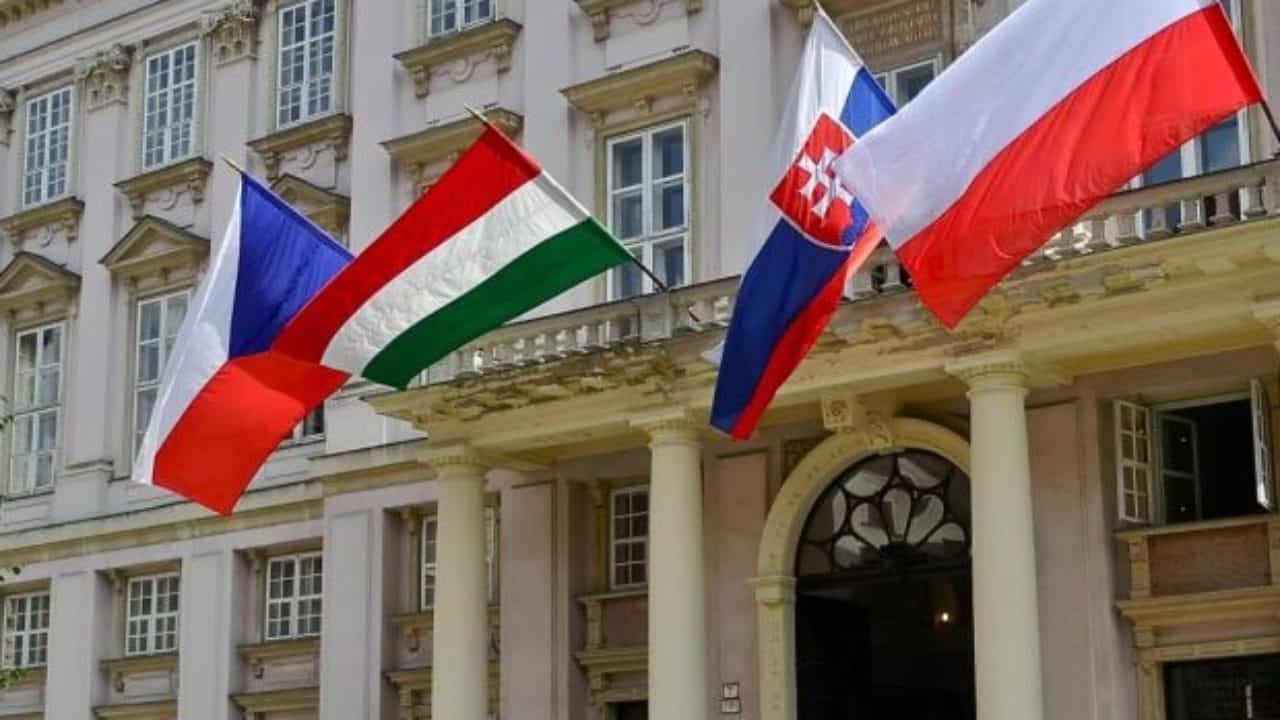In December 2023, Blue Europe published The Dragon at the Gates of Europe: Chinese presence in the Balkans and Central-Eastern Europe. The book presents a discussion of the evolution of economic and diplomatic relations between China and CEE-NEE-SEE countries. It notes that, while relations have generally seen a surge in the 2010s, this has been followed by a decline in the 2020s, drastically accentuated by the 2022 invasion of Ukraine.
Of particular interest is the relationship between China and the Visegrad Group (V4), comprising Poland, Hungary, the Czech Republic, and Slovakia. Especially for the significance of these four countries: if considered as a unified nation, the V4 would be an economic powerhouse in the heart of Europe [1]. It would possess the fourth largest Gross Domestic Product in the European Union, the fifth largest in Europe, and the fifteenth largest globally. Moreover, the V4 countries are leading not only in Europe but also globally in terms of international trade, ranking 4th in the EU, 5th in Europe, and 8th globally.
The multifaced and multilateral relations between V4 countries and China
The relations between the V4 group and China have become a subject of growing interest and complexity in recent years [2]. This multifaceted interaction encompasses economic, political, and security dimensions, which are influenced by broader global dynamics and regional specifics. In particular, the individual positions of the four countries in relation to the Russo-Ukrainian conflict and their general approach to cooperation with China have led to significant divergences within the V4, adding further complexity to their integration and the broader enlargement of the EU [3].
China’s economic involvement with the Visegrad Group has been marked by both opportunities and challenges. Hungary has been particularly receptive to Chinese investments, driven by a series of strategic agreements [4]. Nevertheless, while the Hungarian government portrays China as a vital economic partner, public perception is mixed. Surveys indicate a degree of skepticism among Hungarians, with concerns about corruption and the potential negative impacts of Chinese investments. High-profile projects like the proposed Fudan University campus in Budapest have sparked significant public protests, reflecting broader apprehensions about China’s growing footprint in Hungary. Economically, the relationship between China and Hungary is multifaceted. Chinese investments in Hungary, although a small fraction of overall FDI, have been strategically significant. Notable projects include Huawei’s European logistics hub and the controversial Budapest-Belgrade railway, a flagship BRI project.
Poland, on the other hand, has experienced a more cautious and fluctuating relationship with China [5]. In Poland, after joining the EU in 2004, the relationship with China grew through initiatives like the Belt and Road Initiative. However, despite signing multiple bilateral agreements, Poland’s high expectations for Chinese investments were largely unmet [6]. Poland’s strong alliance with the US, especially concerning security and technology, further influenced its cautious stance towards China. Although economic ties remain, Poland’s geopolitical strategy is heavily shaped by its relationships with the US and its concerns over Russian aggression. Despite high-profile projects like the construction of the S14 expressway and sections of Rail Baltica by Chinese companies, Poland’s overall trade deficit with China remains significant. Moreover, Poland’s alignment with the United States, especially in technological and security domains, has further complicated its relationship with China.
Security concerns also play a pivotal role in shaping V4 relations with China. The Russian invasion of Ukraine has heightened these concerns, especially for countries like Poland and the Baltic states, which view China’s support for Russia with suspicion. This geopolitical tension has strained their relations with Beijing, as they prioritize security alliances with the United States and NATO over economic benefits from China [7]. In contrast, Hungary has shown a more ambivalent attitude towards the Russian aggression, which has allowed them to maintain and, in some cases, even strengthen their ties with China. This pragmatic approach aims to balance their foreign policy by leveraging Chinese investments and support, while navigating their complex relations with both the West and Russia [8].
Looking ahead, V4 countries’ relationships with China should aim to be more coordinated and unified. By working together and speaking with a single voice, the V4 can enhance their collective bargaining power and foster deeper integration within Central and Eastern Europe. This unified approach will help balance economic engagements with China while addressing political and security concerns. A cohesive strategy will not only strengthen the V4’s position in their dealings with China but also promote regional stability and integration, thereby fortifying the European Union as a whole.
Interview with Dr. Marcin Adamczyk
Interview conducted by Jan Normann.
To delve deeper into the topic, we interviewed Dr. Marcin Adamczyk, an expert on Chinese influence in V4 countries. Dr. Adamczyk holds a PhD in political science and administration, he is an Assistant Professor and Deputy Director for Educational and Student Affairs at the Institute of European Studies, University of Wrocław. He is also the vice president and co-founder of the “Projekt Akademia” association and a member of the Polish Geopolitical Society. Author of numerous publications and papers on security and international relations, he specializes in the topic of hegemonic rivalry. Below questions and answers.
1. What are the current relations between Central European countries and China?
There is no simple answer to this question – first, it is worth starting with defining what Central Europe actually is. From Beijing’s perspective, it covers an area from Estonia to the farthest corner of the Balkans (including Greece) – as that was the composition of the 17+1 format initiated by China, intended to serve as a multilateral platform for economic and political consultation and cooperation. I think that for our discussion, we can include the Balkan Peninsula in Central Europe but exclude everything west of the Oder River – since from the Chinese perspective, Germany or Austria should already be considered Western Europe. Moreover, I think this is also their perspective in our country – perhaps rooted in the Polish People Republic era but still relevant. From a cultural-historical standpoint and even the current level of socio-economic development, we are still closer to the Balkans than the German-speaking countries. On the other hand, we know well how different the interests and their perceptions can be among neighbouring countries, let alone those separated by almost the entire length of the continent. Interestingly, however, for decision-makers in Beijing, the borders between the countries in our region have essentially blurred, and Central Europe has appeared to them in recent years as an amalgam of vaguely defined peoples who do not differ significantly from each other – which, for obvious reasons, has not brought the Chinese success in their relations with our region. It is not just about national pride and the need to distinguish oneself from others, but perhaps primarily about different, often conflicting interests.
Returning to the question – I think that in answering it, the countries in our region can be divided into three categories. The first includes the Baltic states, which have essentially severed any cooperation with China or at least withdrawn from the aforementioned 16(17)+1 format – Lithuania has even become a victim of an explicitly undeclared trade war by Beijing. The second category includes countries like Poland or the Czech Republic, which generally do not align with China but still maintain formally correct political and economic relations with China despite American pressures (though there are occasional minor or major frictions). Most countries fall into this category, though the temperature of their relations with Beijing varies. Finally, the last category includes Serbia and Hungary, which openly show their friendship towards China (and Chairman Xi Jinping personally), still hoping that China will play the role of a third vector in their foreign policy – both Budapest and Belgrade, on the one hand, have limited trust or even dislike towards the broadly defined West, but their attitude towards Russia is also not unequivocal (contrary to often repeated opinions). I think there is an awareness in both capitals that in the current world, it is difficult to “sit on the fence,” and at the same time, prosperity is only possible in close relations with the Western world (again broadly defined – including Japan and South Korea). Therefore, I do not foresee any lasting love for China here – rather a temporary infatuation, appropriately fueled by the Chinese with “expensive gifts” and numerous compliments, which the leaders of both countries crave for various reasons.
2. Is China a key partner for these countries?
Objectively speaking, no – investments or trade with Chinese provenance in our region are essentially a drop in the ocean of China’s global engagement. In both cases, they do not exceed 2% of the volume. It is worth noting that the trade value between Central European countries and China, although it exceeded $100 billion a few years ago, is permanently deficit for all countries in the region – an extreme example is Poland, which annually imports from China over ten times more than it exports, resulting in a deficit exceeding $20 billion each year. Next in line are the Czech Republic ($8 billion deficit), followed by Hungary, Slovenia (about $3 billion each), and Romania ($2 billion). Regarding investments, the situation is a bit more nuanced – it is worth remembering that Beijing generally successfully uses investments as a tool of foreign policy, thereby rewarding friendly countries (there are exceptions, but they usually involve technologies and resources needed by the Chinese, which they cannot obtain otherwise). Therefore, indeed in Serbia or Hungary, Chinese investments are noticeable, reaching from several to even tens of percent of the total foreign investments in these countries (though the latter value seems a bit exaggerated to me). On the other hand, in Poland, it is about 1% – objectively speaking, next to nothing, considering the size of the Chinese economy.
3. How has the war in Ukraine affected relations between these countries and China?
Definitely – in the case of countries that previously had a more or less reserved attitude towards China, these relations have worsened. One can use the neorealist paradigm in the study of international relations and security, one of whose principles is the primacy of so-called high politics over low politics – in short, security over economic benefits. By almost uncritically supporting the Russian invasion – both politically and materially – China has, from the perspective of the Baltic states, Poland, or the Czech Republic, become partly responsible for the prolongation of the Russian aggression. Interestingly, there is complete disregard in Beijing for this issue, resulting in a lack of understanding of the concerns of countries whose history of relations with Russia has not been positive. Therefore, there is a correlation between attitudes towards the Russo-Ukrainian war and the temperature of relations with China. Hungary and Serbia, known for their ambivalent – to put it mildly – attitude towards the Russian aggression in Ukraine, are simultaneously strengthening their relations with China. On the other hand, the war has only been a catalyst for processes that have been observable since the pandemic – their best emanation was the so-called “wolf warrior diplomacy” of the Chinese, but also regular accusations of espionage against Chinese diplomats or businessmen, as well as attempts to influence public opinion in a morally ambiguous way, and finally, disappointment with the previously mentioned lackluster results of bilateral cooperation.
4. What are the key areas of cooperation and disputes between China and the Visegrad Group countries?
It is hard to say that there are specific areas of China’s relations with the countries in the region that are characteristic of the Visegrad Group. The Chinese did not even specifically treat the Group as a separate entity on the map of Central Europe – as evidenced by rather sporadic meetings of decision-makers in the 4+1 format. From China’s perspective, the most important aspect is the membership of all Visegrad Group countries in the European Union. Beijing’s decision-makers assumed that the countries in the region would, on the one hand, serve as a kind of testing ground for Chinese companies to “prove themselves” in the activities of the common market, and on the other hand, sufficiently courted by investments from China, would lobby in Brussels on behalf of China. As we know, these plans came to little – Budapest may indeed be in favour of China, but its ability to influence EU policy hovers around zero. Poland and the Czech Republic have chosen a course of rapprochement with the United States – which they see as the only reliable security guarantor in the region – which necessarily determines a collision course with Chinese policy. In the EU itself, they are also seen as anti-China, especially compared to countries with a rather ambiguous policy towards China, such as Germany or, to a lesser extent, France. So far, Slovakia has also not been particularly favourable to China, but the current attitude of this country towards Russia raises questions about what policy Bratislava will pursue towards China in the short term.
5. What is the significance of China’s presence in these countries?
As I mentioned earlier, Beijing’s economic presence in the Visegrad Group countries is – apart from Hungary – rather negligible and does not play a significant role in their functioning. It seems that we talk a lot about China – and rightly so – yet the manifestations of Chinese presence are relatively few. Although Chinese companies have dominated – hopefully temporarily – some specific sectors of the economy (such as the infamous 5G infrastructure), their significance remains relatively small. Nevertheless, it is worth being alert to the threat from the Chinese and being aware that under the guise of modern technology, cities looking like Western metropolises, there still lies a nation negatively disposed towards the West, convinced of its superiority over it, and simultaneously striving for confrontation. Furthermore, China’s approach to human rights – including privacy – is vastly different from ours, so let’s not be surprised if one day our Chinese juicer connected to the local Wi-Fi network knows more about us than we do ourselves.
References
-
Michał Przybyliński and Joanna Trębska (Sep 2023), “Intersectoral Flows in the Economies of the Visegrad Group Countries.” Comparative Economic Research Central and Eastern Europe 26(3):31-52 DOI: 10.18778/1508-2008.26.20 ↑
-
Zdeněk Rod (Dec 2023), “The Chinese Influence in Visegrad Countries,” in: Andrea Bogoni and Brian F. G. Fabrègue, eds., “The Dragon at the Gates of Europe: Chinese Presence in the Balkans and Central-Eastern Europe,” Blue Europe: pp. 271-296. ISBN: 979-8989739806. ↑
-
Nino Gozalishvili (Dec 2023), “Disintegration through Integration? Turning to the Transnational Approach to Study National-Populism on the Example of the Visegrád Group.” Centre for Euro-Atlantic Integration and Democracy. ↑
-
Réka Koleszár (Dec 2023), “Chinese influence in Hungary: a multifaced relationship,” in: Andrea Bogoni and Brian F. G. Fabrègue, eds., “The Dragon at the Gates of Europe: Chinese Presence in the Balkans and Central-Eastern Europe,” Blue Europe, Dec 2023: pp. 357-375. ISBN: 979-8989739806 ↑
-
Zdeněk Rod (Dec 2023), “The Chinese Influence in Visegrad Countries.” ↑
-
Marcin Przychodniak , “China and the Visegrad Group. Transformation and future of the cooperation.” Ośrodek Myśli Politycznej. Available at: https://usa-ue.pl/teksty-i-komentarze/english/china-and-the-visegrad-group-transformation-and-future-of-the-cooperation/. ↑
-
Łukasz Kobierski (Feb 2022), “The Role and Influence of The People’s Republic of China on Visegrad Group Countries.” Warsaw Institute. Available at: https://warsawinstitute.org/role-influence-peoples-republic-china-visegrad-group-countries/ ↑
-
Dimitar Bechev (May 2024) “Is China Stealing Russia’s Thunder in Eastern Europe?” Commentary, Carnegie Politika. Available at: https://carnegieendowment.org/russia-eurasia/politika/2024/05/china-russia-eastern-europe?lang=en¢er=russia-eurasia ↑





